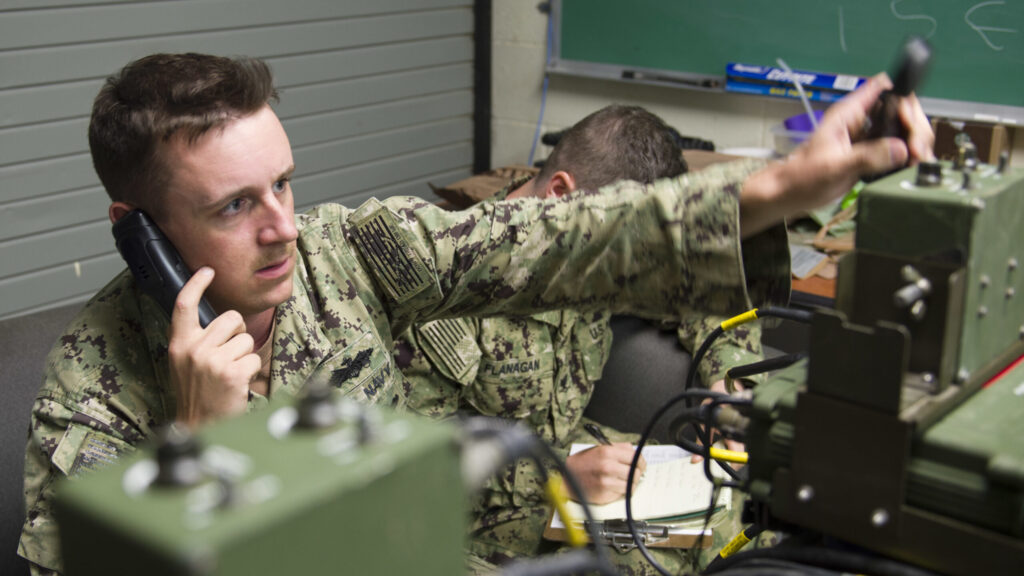
Electronics Technician 2nd Class Anthony Juarez and Electronics Technician 3rd Class Codie Flanagan adjust frequency codes on a GRC-234 high-frequency base station at Naval Base Guam July 27, 2017. (US Navy Combat Camera photo by Fire Controlman 2nd Class Alexander Lee)
WASHINGTON — The Naval Research Laboratory plans to begin tests this spring of a pair of ionospheric sensors on the International Space Station — tests that if successful could lead to a constellation of monitoring satellites that would enhance Defense Department high frequency radio communications.
The Experiment for Characterizing the Lower Ionosphere & Prediction of Sporadic-E (ECLIPSE) sensors are slated to launch to the ISS in March via the DoD Space Test Program, Andrew Nicholas, one of the effort’s lead researchers, told Breaking Defense in an email.
The ionosphere occupies a region around 85 kilometers (53 miles) to more than 600 kilometers (373 miles) in altitude, where solar radiation ionizes the atmosphere, creating charged plasma that interacts with the Earth’s ambient electric and magnetic fields. As a result, the ionosphere can transmit, refract and reflect radio waves.
“Understanding the ionosphere is important to the DoD because it can impacts how radio waves pass through it or are reflected by it,” Nicholas said.
The Navy, Army and Air Force all use HF radio communications for long-range communications, but over the past couple of decades they have more heavily relied on satellite communications — especially the Navy for its high-speed, high-data-rate comms with ships on open ocean. Now, with concerns on the rise about the vulnerability of US satellites as Russia and China built up capabilities to degrade or destroy them, HF radio is having a bit of a renaissance as a reliable alternative in case military SATCOM channels go dark in a conflict.
The two ECLIPSE sensors are based on an earlier design developed for NRL’s Coordinated Ionospheric Reconstruction CubeSat Experiment (CIRCE) project with the UK Defence Science and Technology Laboratory. CIRCE involved two tiny CubeSats, each equipped with multiple sensors to study the ionosphere, but those were destroyed in the failed Virgin Orbit launch from Cornwall on Jan. 10.
The sensor NRL provided for the CIRCE satellites was called the Triple Tiny Ionospheric Photometer (Tri-TIP), and was designed to measure ‘airglow’ in the nighttime atmosphere caused by radiation.
“The CIRCE development allowed NRL to design a low size, weight and power (10 x 10 x 10 cm, 890 g, 14 W) ionospheric remote sensing instrument to measure the glow from nightside oxygen ions (O+). The Tri-TIP design was used as a baseline configuration, and modified for to measure magnesium ions (Mg+),” Nicholas said.
The Office of Naval Research sponsored the development of the Tri-TIP sensor, and the Defense Advanced Research Projects Agency sponsored the magnesium sensor, which goes by the moniker of Tri-MIP, he added, noting that both will fly “in tandem” onboard the ISS.
Specifically, the goal is to measure ionospheric particle density that affects how radio waves travel through it, Nicholas explained.
“The ionosphere glows due to different physics/chemistry. By observing this naturally occurring light at different wavelengths … we can determine how many ions there are along the line of sight. Knowing this provides information on the electron density contribution from nightside O+ or dayside Mg+. The different physics and chemistry drives the airglow differently day (processes driven by sunlight) to night (no sun). The electron density is important for HF communications, over the horizon radar, and other applications,” he said.
If the experiment is successful, Nicholas said, not only can the data be used to improve ionospheric monitoring models, but perhaps down the road lead to the development of specialized satellites to keep continuous tabs on ionospheric changes that might affect HF communications.
“Once validated the data can be ingested into data assimilative models like Next-generation Ionospheric Model for Operations (NIMO),” he said. “The low SWAP [size, weight and power] nature of the instrument is conducive to flying multiple units in a constellation for global coverage.”
Air Force picks Anduril, General Atomics for next round of CCA work
The two vendors emerged successful from an original pool of five and are expected to carry their drone designs through a prototyping phase that will build and test aircraft.


























